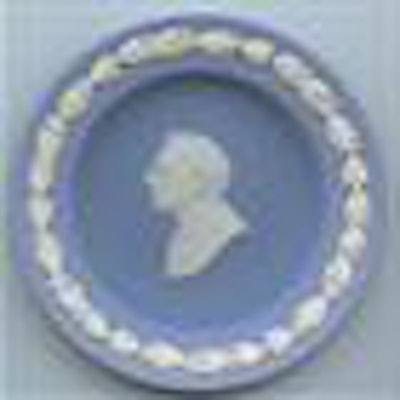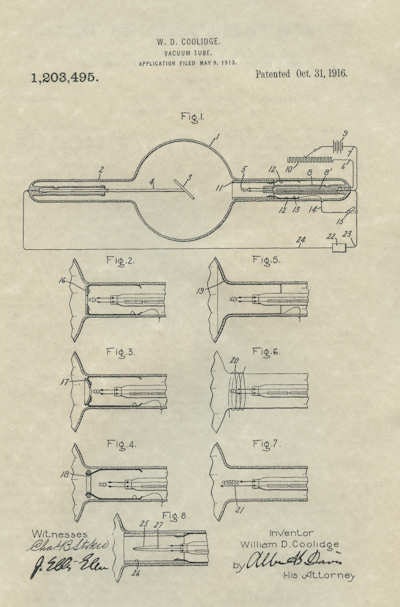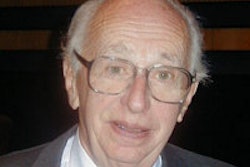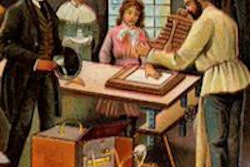
This year marks the centenary of the development of the so-called hot cathode, also known as the Coolidge x-ray tube. Modern x-ray tubes are still based on this design and variations of it, so the pioneering work of its amazing inventor remains relevant today.
 William David Coolidge, 1926.
William David Coolidge, 1926.William David Coolidge (1873-1975) was born in Hudson, Massachusetts, U.S., on 23 October 1873. In 1905 he joined the General Electric Company Research Laboratory, where he worked until he retired in 1944. In 1906 he discovered how to make molybdenum and tungsten ductile, and this was a major discovery. Prior to this, these metals were seen as being unworkable because they were far too brittle. The ductile tungsten could be made into good lamp filaments, replacing the earlier carbon filaments.
When working with x-ray tubes, Coolidge found a particular tube that worked well when the cathode became heated. He worked with Irving Langmuir, who was studying electron emissions from hot tungsten filaments. It was found that even in the highest vacuum that the electron emission was stable and reproducible. It occurred to Coolidge that this could be adapted for use in the x-ray tube.
 Coolidge tube.
Coolidge tube.On 12 December 1913, he wrote in his notebook that, "I.L. (Langmuir) tells me that in his study of the Edison Effect, current from the hot cathode is greater with vacuum of 0.01 or 0.02 micron than at higher pressure (except in case of argon). I will try this at once in an x-ray tube in which I can heat the cathode."
The Edison Effect is also known as thermionic emission, and is the emission of electrons from a hot cathode within a vacuum tube. This effect had initially been reported by Frederick Guthrie in 1873 in the U.K. Guthrie was working with charged objects. He found that a positively charged red-hot iron sphere would discharge, but that this did not happen if the sphere had a negative charge. This effect was rediscovered by Thomas Edison, from the U.S., on 13 February 1880, when he was trying to find why the filaments in his incandescent lamps were breaking.
The GE team then developed a high-vacuum tube with a heated tungsten filament acting as the cathode and a tungsten disk as the anode. The tubes were evacuated, and initially the green fluorescence of glass that always took place when x-ray tubes were operated was observed. As the vacuum increased, the fluorescence disappeared and the tube became stable and controllable. The ions in the tube that were previously needed became unnecessary. The limitations of the older tubes were largely secondary to the presence of these ions.
The first new tube was used by the well-known radiologist Lewis Gregory Cole, from New York. The new tube was enclosed in an open-topped lead glass bowl, and was demonstrated at a dinner in a New York hotel on 27 December 1913. Up to this point the x-ray generators had a capacity considerably higher than the older x-ray tubes could endure. With his characteristic modesty, Coolidge wanted to call the new design the "GE Tube," but Cole proposed the name of "Coolidge Tube" and this is what stuck.

 Left: "The Cool-Edge Tube" (1916), as illustrated by George Morrow. Right: Wedgwood Jasper plate celebrating William Coolidge and produced for Climax Molybdenum Company, New York.
Left: "The Cool-Edge Tube" (1916), as illustrated by George Morrow. Right: Wedgwood Jasper plate celebrating William Coolidge and produced for Climax Molybdenum Company, New York.Coolidge wanted to test the new tube on humans, and so used himself as a test subject with disastrous effects. Whilst this went well initially, he became concerned when his hair started to fall out. Therefore, he obtained an embalmed leg from a local physician. When Coolidge had finished his experiments, he took the leg to the company's incinerator for disposal, and he threw the leg into the incinerator with no explanation.
The operator did not know much English and opened the incinerator. The covering came apart and he was horrified to see a human leg. He was convinced he had come across a dreadful crime and he called the company police. A detective then visited Coolidge, and he had to give a very lengthy explanation! Further experiments on the tube resulted in the observations that the radiographic contrast deepened on the tube voltage and that the resolution depended on the size and position of the focal spot.
War-time activities
 Spiral cathode (left) and tungsten anode (right). Note the elegant shape of the anode and the anode angle of 45° before the development of line focus.
Spiral cathode (left) and tungsten anode (right). Note the elegant shape of the anode and the anode angle of 45° before the development of line focus.During World War I, Coolidge became involved in producing a dependable portable unit for military use. The individual elements were simple and light and could be easily transported. Attached was a petrol-driven generator. The new tube had many benefits for military use and could be operated for long periods of time without overheating.
It might be imagined that the new Coolidge tube would rapidly sweep away the old ion/gas tubes, but in fact the gas tubes survived for a considerable period of time because they were readily available and relatively cheap. For example, in G.C. Aimer's catalogue, a standard gas tube was for sale in the U.K. at 7.75 pounds. The Coolidge tube sold at 40 pounds, more than five times the cost. Aimer was forced, however, to admit "the Coolidge tube has certain advantages over the gas tube."
Coolidge continued to work in x-rays and in the 1930s developed a 900,000-volt tube. He was also deeply involved in nondestructive testing. Coolidge received many honors and was personally very modest. He said, "Such honors as this I accept only if I can some-how share them with many others, since the entire staff of our research laboratory contributed to the success of this work." Our modern tubes are developments of this Coolidge tube of 1913 and we owe to Coolidge and his memory our sincere thanks.
 U.S. Patent No. 1,203,495 for a vacuum tube, inventor William D. Coolidge, application filed 9 May 1913.
U.S. Patent No. 1,203,495 for a vacuum tube, inventor William D. Coolidge, application filed 9 May 1913.Dr. Adrian Thomas is chairman of the International Society for the History of Radiology and honorary librarian at the British Institute of Radiology.
References
- Liebhafsky HA, Coolidge WD. A Centenarian and his work. New York, NY: John Wiley & Sons; 1974.
- Miller JA. Yankee Scientist: William David Coolidge. Schenectady, NY: Mohawk Development Service; 1963.
- X-ray studies. Schenectady, NY: General Electric Company; 1919.
The comments and observations expressed herein do not necessarily reflect the opinions ofAuntMinnieEurope.com, nor should they be construed as an endorsement or admonishment of any particular vendor, analyst, industry consultant, or consulting group.



















